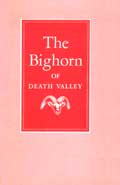.gif)
MENU
![]() Photographs
Photographs
|
Fauna of the National Parks — No. 6
The Bighorn of Death Valley |

|

Figure 8.—At Willow Creek,
in July 1955, the upper spring in the willows at right had not been used
by bighorn for many years. In 1956 they beat trails through these
willows and used the water at that place for one summer, but usually
they prefer to water at more open spots further down the
canyon.

Figure 9.—Water flows
intermittently down Willow Creek for 3 miles. Permanent water situated
in rugged escape terrain has made this the home area for one of the
region's largest concentrations of bighorn.

Figure 10.—On Paleomesa
above Navel Spring, in December 1955, we watched a "band" form, first
two, then five, seven, and finally eight. Their leader Old Mama
(foreground), accepted us as a condition of the environment and fed
closer as the days passed.

Figure 11.—Within a few days
Old Mama led the band down off the mesa into the Big Wash and bedded
them on the mesa over a mile from any "cliffy terrain" hitherto supposed
necessary to the sense of security of all bighorn at bedding
time.

Figure 12.—From Big Wash she
led them on down to Deadman's Curve and back up Furnace Creek Wash.
Bebbia juncea and Stephanomeria dominate both these
washes, though not the mesa, and began immediately to assume a place of
primary importance in the Death Valley bighorn diet.

Figure 13.—By the 5th of
January, 1956, Old Mama had not only induced the band to follow her
across the highway, but they no longer paid any attention to the cars
stopping and people pouring out to photograph them.

Figure 14.—Finally on
January 10, following Old Mama's example, the entire band stood
stockstill in the middle of the highway, bringing all traffic to a halt.
It should be emphasized that such tolerance with respect to humans is
most unusual, and it developed in response to a unique
leadership.
Continued >>>
 Top
Top
Last Modified: Thurs, May 16 2002 10:00:00 pm PDT
http://www.cr.nps.gov/history/online_books/fauna6/faunap1.htm
![]()
